Exploring Social Determinants of Health in Indigenous Australians
VerifiedAdded on 2023/06/14
|9
|2017
|356
Report
AI Summary
This report examines the influence of social determinants of health (SDH) on the wellbeing of Indigenous Australian communities, highlighting the health gap between Indigenous and non-Indigenous populations. It focuses on five key determinants: education/literacy, employment and working conditions, health practices and coping skills, gender, and genetics. The report details how these factors contribute to health discrepancies, increasing the risk of long-term health conditions among Indigenous Australians. It emphasizes that disparities in education, employment opportunities, and healthcare access, coupled with adverse health practices and genetic predispositions, significantly impact the quality of life, life expectancy, and mortality rates within these communities. Ultimately, the report underscores the importance of addressing these social determinants to improve the health and wellbeing of Indigenous Australians.
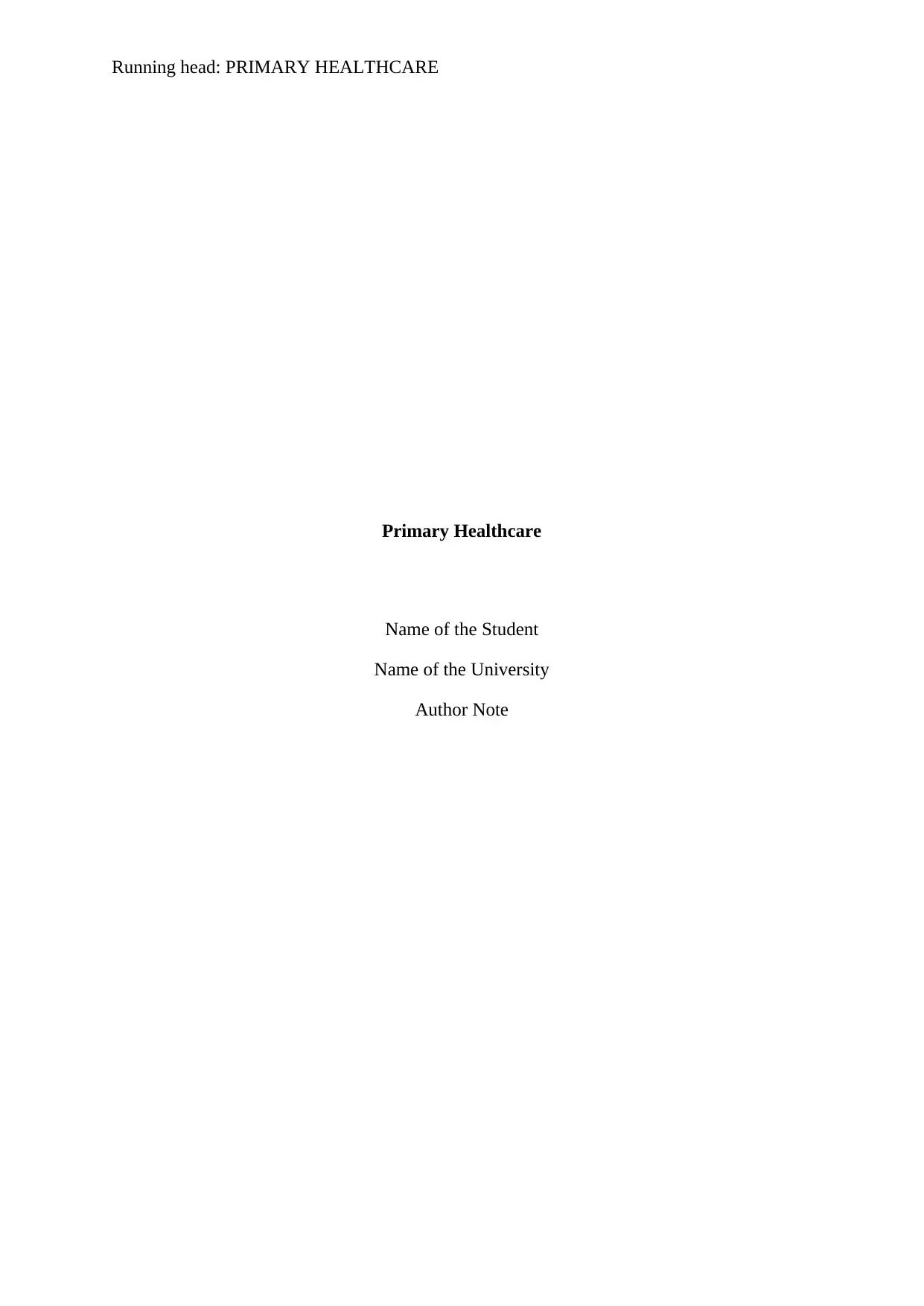
Running head: PRIMARY HEALTHCARE
Primary Healthcare
Name of the Student
Name of the University
Author Note
Primary Healthcare
Name of the Student
Name of the University
Author Note
Paraphrase This Document
Need a fresh take? Get an instant paraphrase of this document with our AI Paraphraser

1PRIMARY HEALTHCARE
Executive Summary
Social determinants of health are the set of conditions in which an individual is
born and raised and it affects their physical and mental wellbeing. These
determinants are outlined in the SDH assessment Circle. Five of these determinants:
Education/Literacy, Employment, Health Practice/Coping, Gender and Genetics are
discussed in the report and how they influence the physical and mental wellbeing of
the Indigenous Australian People. From the discussion of these 5 determinants, it
was evident that such determinants underlie the health gap and health discrepancies
between the healths of the Indigenous Australians with the Non Indigenous
Australian population. Such determinants increase the risks of the Indigenous people
to various long term health conditions, which adversely affect their health and
wellbeing.
Executive Summary
Social determinants of health are the set of conditions in which an individual is
born and raised and it affects their physical and mental wellbeing. These
determinants are outlined in the SDH assessment Circle. Five of these determinants:
Education/Literacy, Employment, Health Practice/Coping, Gender and Genetics are
discussed in the report and how they influence the physical and mental wellbeing of
the Indigenous Australian People. From the discussion of these 5 determinants, it
was evident that such determinants underlie the health gap and health discrepancies
between the healths of the Indigenous Australians with the Non Indigenous
Australian population. Such determinants increase the risks of the Indigenous people
to various long term health conditions, which adversely affect their health and
wellbeing.
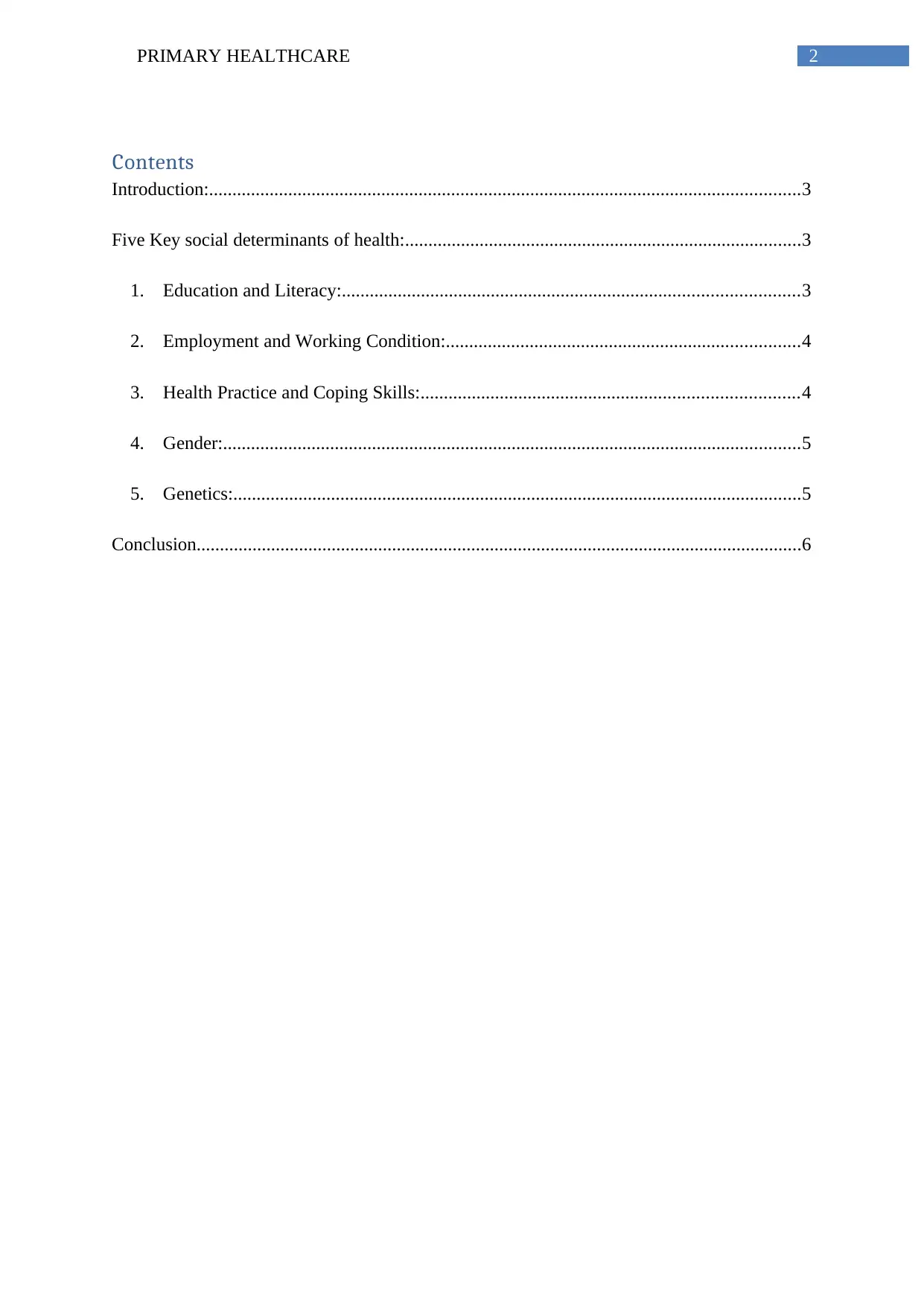
2PRIMARY HEALTHCARE
Contents
Introduction:...............................................................................................................................3
Five Key social determinants of health:.....................................................................................3
1. Education and Literacy:..................................................................................................3
2. Employment and Working Condition:............................................................................4
3. Health Practice and Coping Skills:.................................................................................4
4. Gender:............................................................................................................................5
5. Genetics:..........................................................................................................................5
Conclusion..................................................................................................................................6
Contents
Introduction:...............................................................................................................................3
Five Key social determinants of health:.....................................................................................3
1. Education and Literacy:..................................................................................................3
2. Employment and Working Condition:............................................................................4
3. Health Practice and Coping Skills:.................................................................................4
4. Gender:............................................................................................................................5
5. Genetics:..........................................................................................................................5
Conclusion..................................................................................................................................6
⊘ This is a preview!⊘
Do you want full access?
Subscribe today to unlock all pages.

Trusted by 1+ million students worldwide
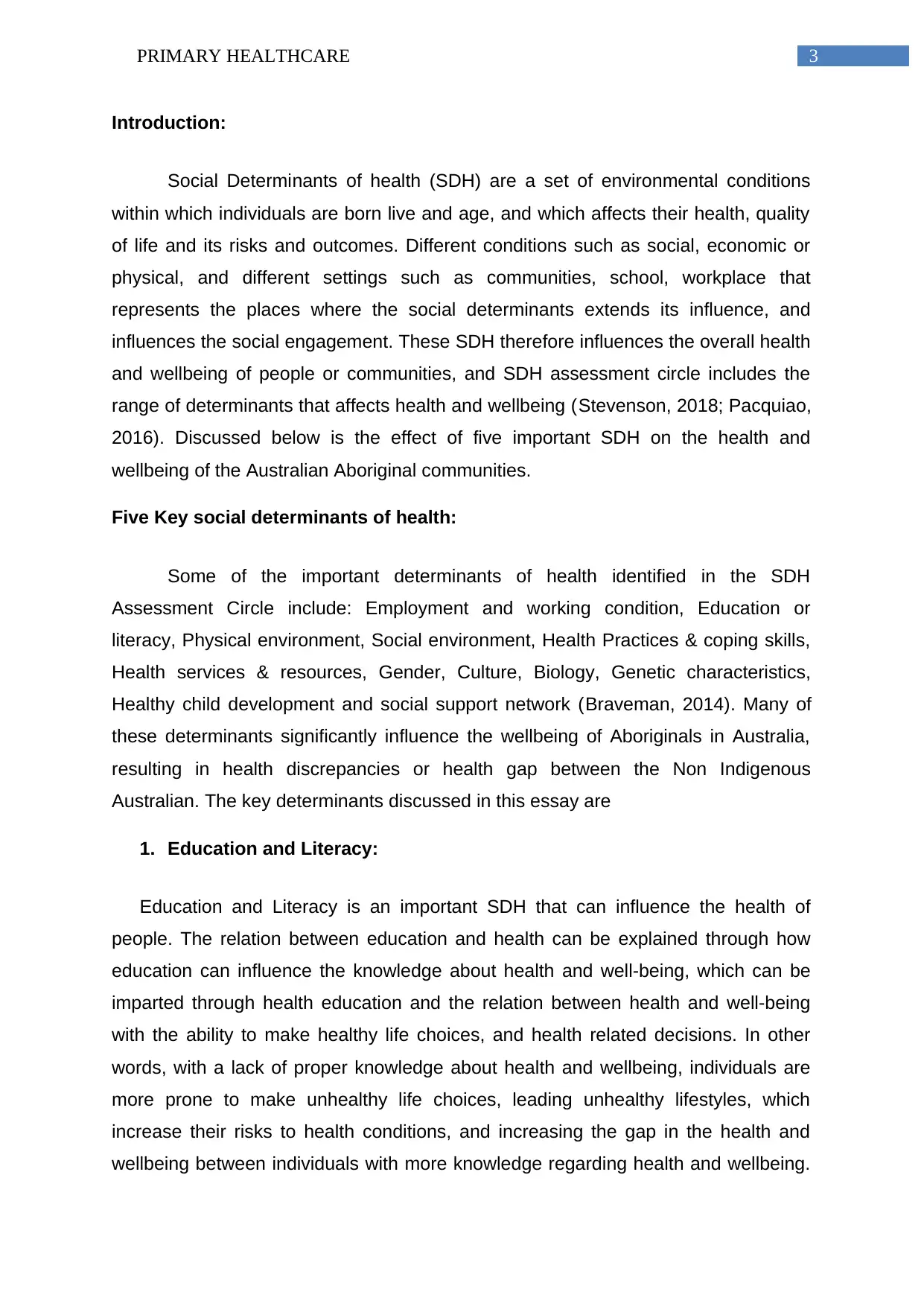
3PRIMARY HEALTHCARE
Introduction:
Social Determinants of health (SDH) are a set of environmental conditions
within which individuals are born live and age, and which affects their health, quality
of life and its risks and outcomes. Different conditions such as social, economic or
physical, and different settings such as communities, school, workplace that
represents the places where the social determinants extends its influence, and
influences the social engagement. These SDH therefore influences the overall health
and wellbeing of people or communities, and SDH assessment circle includes the
range of determinants that affects health and wellbeing (Stevenson, 2018; Pacquiao,
2016). Discussed below is the effect of five important SDH on the health and
wellbeing of the Australian Aboriginal communities.
Five Key social determinants of health:
Some of the important determinants of health identified in the SDH
Assessment Circle include: Employment and working condition, Education or
literacy, Physical environment, Social environment, Health Practices & coping skills,
Health services & resources, Gender, Culture, Biology, Genetic characteristics,
Healthy child development and social support network (Braveman, 2014). Many of
these determinants significantly influence the wellbeing of Aboriginals in Australia,
resulting in health discrepancies or health gap between the Non Indigenous
Australian. The key determinants discussed in this essay are
1. Education and Literacy:
Education and Literacy is an important SDH that can influence the health of
people. The relation between education and health can be explained through how
education can influence the knowledge about health and well-being, which can be
imparted through health education and the relation between health and well-being
with the ability to make healthy life choices, and health related decisions. In other
words, with a lack of proper knowledge about health and wellbeing, individuals are
more prone to make unhealthy life choices, leading unhealthy lifestyles, which
increase their risks to health conditions, and increasing the gap in the health and
wellbeing between individuals with more knowledge regarding health and wellbeing.
Introduction:
Social Determinants of health (SDH) are a set of environmental conditions
within which individuals are born live and age, and which affects their health, quality
of life and its risks and outcomes. Different conditions such as social, economic or
physical, and different settings such as communities, school, workplace that
represents the places where the social determinants extends its influence, and
influences the social engagement. These SDH therefore influences the overall health
and wellbeing of people or communities, and SDH assessment circle includes the
range of determinants that affects health and wellbeing (Stevenson, 2018; Pacquiao,
2016). Discussed below is the effect of five important SDH on the health and
wellbeing of the Australian Aboriginal communities.
Five Key social determinants of health:
Some of the important determinants of health identified in the SDH
Assessment Circle include: Employment and working condition, Education or
literacy, Physical environment, Social environment, Health Practices & coping skills,
Health services & resources, Gender, Culture, Biology, Genetic characteristics,
Healthy child development and social support network (Braveman, 2014). Many of
these determinants significantly influence the wellbeing of Aboriginals in Australia,
resulting in health discrepancies or health gap between the Non Indigenous
Australian. The key determinants discussed in this essay are
1. Education and Literacy:
Education and Literacy is an important SDH that can influence the health of
people. The relation between education and health can be explained through how
education can influence the knowledge about health and well-being, which can be
imparted through health education and the relation between health and well-being
with the ability to make healthy life choices, and health related decisions. In other
words, with a lack of proper knowledge about health and wellbeing, individuals are
more prone to make unhealthy life choices, leading unhealthy lifestyles, which
increase their risks to health conditions, and increasing the gap in the health and
wellbeing between individuals with more knowledge regarding health and wellbeing.
Paraphrase This Document
Need a fresh take? Get an instant paraphrase of this document with our AI Paraphraser
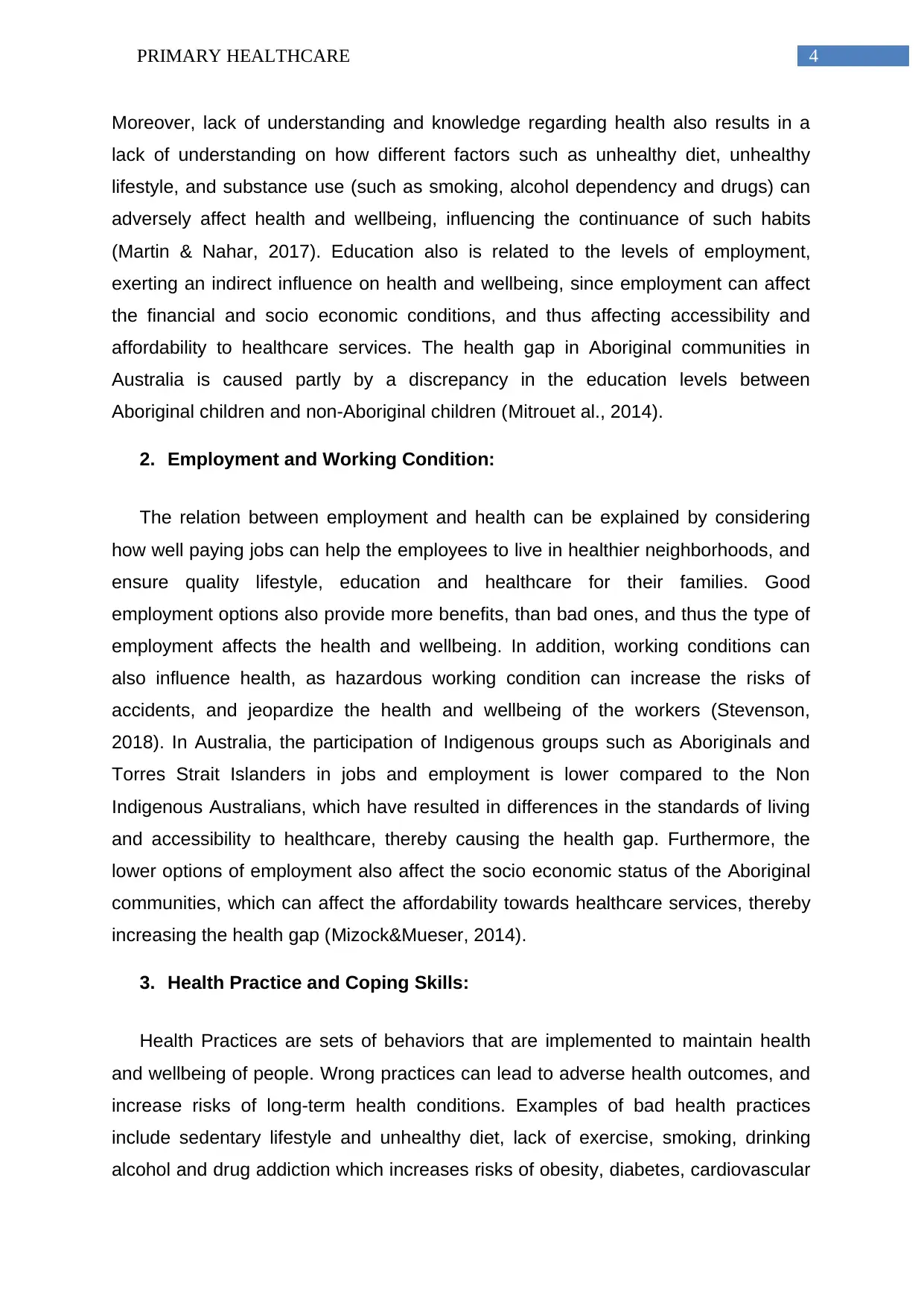
4PRIMARY HEALTHCARE
Moreover, lack of understanding and knowledge regarding health also results in a
lack of understanding on how different factors such as unhealthy diet, unhealthy
lifestyle, and substance use (such as smoking, alcohol dependency and drugs) can
adversely affect health and wellbeing, influencing the continuance of such habits
(Martin & Nahar, 2017). Education also is related to the levels of employment,
exerting an indirect influence on health and wellbeing, since employment can affect
the financial and socio economic conditions, and thus affecting accessibility and
affordability to healthcare services. The health gap in Aboriginal communities in
Australia is caused partly by a discrepancy in the education levels between
Aboriginal children and non-Aboriginal children (Mitrouet al., 2014).
2. Employment and Working Condition:
The relation between employment and health can be explained by considering
how well paying jobs can help the employees to live in healthier neighborhoods, and
ensure quality lifestyle, education and healthcare for their families. Good
employment options also provide more benefits, than bad ones, and thus the type of
employment affects the health and wellbeing. In addition, working conditions can
also influence health, as hazardous working condition can increase the risks of
accidents, and jeopardize the health and wellbeing of the workers (Stevenson,
2018). In Australia, the participation of Indigenous groups such as Aboriginals and
Torres Strait Islanders in jobs and employment is lower compared to the Non
Indigenous Australians, which have resulted in differences in the standards of living
and accessibility to healthcare, thereby causing the health gap. Furthermore, the
lower options of employment also affect the socio economic status of the Aboriginal
communities, which can affect the affordability towards healthcare services, thereby
increasing the health gap (Mizock&Mueser, 2014).
3. Health Practice and Coping Skills:
Health Practices are sets of behaviors that are implemented to maintain health
and wellbeing of people. Wrong practices can lead to adverse health outcomes, and
increase risks of long-term health conditions. Examples of bad health practices
include sedentary lifestyle and unhealthy diet, lack of exercise, smoking, drinking
alcohol and drug addiction which increases risks of obesity, diabetes, cardiovascular
Moreover, lack of understanding and knowledge regarding health also results in a
lack of understanding on how different factors such as unhealthy diet, unhealthy
lifestyle, and substance use (such as smoking, alcohol dependency and drugs) can
adversely affect health and wellbeing, influencing the continuance of such habits
(Martin & Nahar, 2017). Education also is related to the levels of employment,
exerting an indirect influence on health and wellbeing, since employment can affect
the financial and socio economic conditions, and thus affecting accessibility and
affordability to healthcare services. The health gap in Aboriginal communities in
Australia is caused partly by a discrepancy in the education levels between
Aboriginal children and non-Aboriginal children (Mitrouet al., 2014).
2. Employment and Working Condition:
The relation between employment and health can be explained by considering
how well paying jobs can help the employees to live in healthier neighborhoods, and
ensure quality lifestyle, education and healthcare for their families. Good
employment options also provide more benefits, than bad ones, and thus the type of
employment affects the health and wellbeing. In addition, working conditions can
also influence health, as hazardous working condition can increase the risks of
accidents, and jeopardize the health and wellbeing of the workers (Stevenson,
2018). In Australia, the participation of Indigenous groups such as Aboriginals and
Torres Strait Islanders in jobs and employment is lower compared to the Non
Indigenous Australians, which have resulted in differences in the standards of living
and accessibility to healthcare, thereby causing the health gap. Furthermore, the
lower options of employment also affect the socio economic status of the Aboriginal
communities, which can affect the affordability towards healthcare services, thereby
increasing the health gap (Mizock&Mueser, 2014).
3. Health Practice and Coping Skills:
Health Practices are sets of behaviors that are implemented to maintain health
and wellbeing of people. Wrong practices can lead to adverse health outcomes, and
increase risks of long-term health conditions. Examples of bad health practices
include sedentary lifestyle and unhealthy diet, lack of exercise, smoking, drinking
alcohol and drug addiction which increases risks of obesity, diabetes, cardiovascular
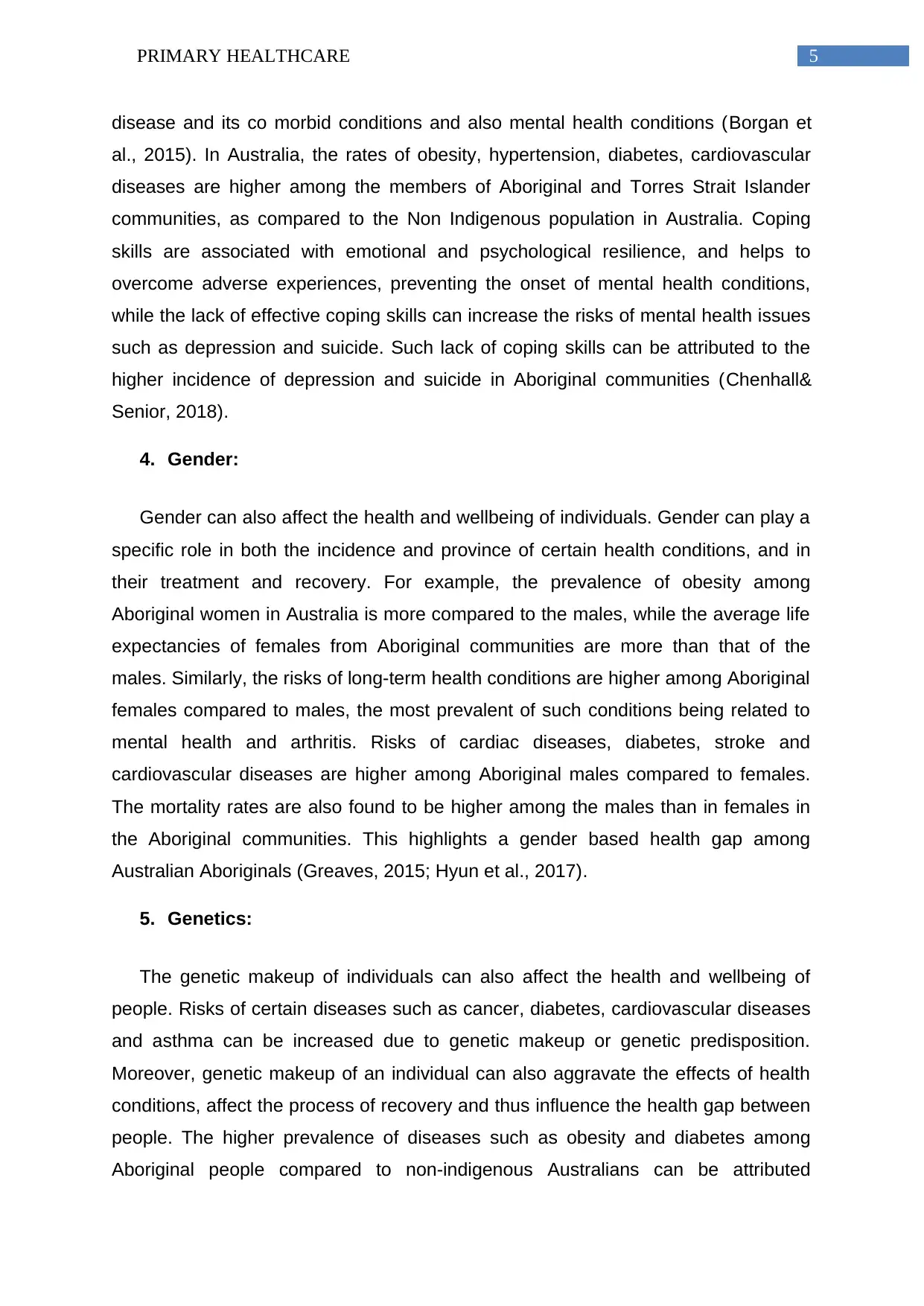
5PRIMARY HEALTHCARE
disease and its co morbid conditions and also mental health conditions (Borgan et
al., 2015). In Australia, the rates of obesity, hypertension, diabetes, cardiovascular
diseases are higher among the members of Aboriginal and Torres Strait Islander
communities, as compared to the Non Indigenous population in Australia. Coping
skills are associated with emotional and psychological resilience, and helps to
overcome adverse experiences, preventing the onset of mental health conditions,
while the lack of effective coping skills can increase the risks of mental health issues
such as depression and suicide. Such lack of coping skills can be attributed to the
higher incidence of depression and suicide in Aboriginal communities (Chenhall&
Senior, 2018).
4. Gender:
Gender can also affect the health and wellbeing of individuals. Gender can play a
specific role in both the incidence and province of certain health conditions, and in
their treatment and recovery. For example, the prevalence of obesity among
Aboriginal women in Australia is more compared to the males, while the average life
expectancies of females from Aboriginal communities are more than that of the
males. Similarly, the risks of long-term health conditions are higher among Aboriginal
females compared to males, the most prevalent of such conditions being related to
mental health and arthritis. Risks of cardiac diseases, diabetes, stroke and
cardiovascular diseases are higher among Aboriginal males compared to females.
The mortality rates are also found to be higher among the males than in females in
the Aboriginal communities. This highlights a gender based health gap among
Australian Aboriginals (Greaves, 2015; Hyun et al., 2017).
5. Genetics:
The genetic makeup of individuals can also affect the health and wellbeing of
people. Risks of certain diseases such as cancer, diabetes, cardiovascular diseases
and asthma can be increased due to genetic makeup or genetic predisposition.
Moreover, genetic makeup of an individual can also aggravate the effects of health
conditions, affect the process of recovery and thus influence the health gap between
people. The higher prevalence of diseases such as obesity and diabetes among
Aboriginal people compared to non-indigenous Australians can be attributed
disease and its co morbid conditions and also mental health conditions (Borgan et
al., 2015). In Australia, the rates of obesity, hypertension, diabetes, cardiovascular
diseases are higher among the members of Aboriginal and Torres Strait Islander
communities, as compared to the Non Indigenous population in Australia. Coping
skills are associated with emotional and psychological resilience, and helps to
overcome adverse experiences, preventing the onset of mental health conditions,
while the lack of effective coping skills can increase the risks of mental health issues
such as depression and suicide. Such lack of coping skills can be attributed to the
higher incidence of depression and suicide in Aboriginal communities (Chenhall&
Senior, 2018).
4. Gender:
Gender can also affect the health and wellbeing of individuals. Gender can play a
specific role in both the incidence and province of certain health conditions, and in
their treatment and recovery. For example, the prevalence of obesity among
Aboriginal women in Australia is more compared to the males, while the average life
expectancies of females from Aboriginal communities are more than that of the
males. Similarly, the risks of long-term health conditions are higher among Aboriginal
females compared to males, the most prevalent of such conditions being related to
mental health and arthritis. Risks of cardiac diseases, diabetes, stroke and
cardiovascular diseases are higher among Aboriginal males compared to females.
The mortality rates are also found to be higher among the males than in females in
the Aboriginal communities. This highlights a gender based health gap among
Australian Aboriginals (Greaves, 2015; Hyun et al., 2017).
5. Genetics:
The genetic makeup of individuals can also affect the health and wellbeing of
people. Risks of certain diseases such as cancer, diabetes, cardiovascular diseases
and asthma can be increased due to genetic makeup or genetic predisposition.
Moreover, genetic makeup of an individual can also aggravate the effects of health
conditions, affect the process of recovery and thus influence the health gap between
people. The higher prevalence of diseases such as obesity and diabetes among
Aboriginal people compared to non-indigenous Australians can be attributed
⊘ This is a preview!⊘
Do you want full access?
Subscribe today to unlock all pages.

Trusted by 1+ million students worldwide
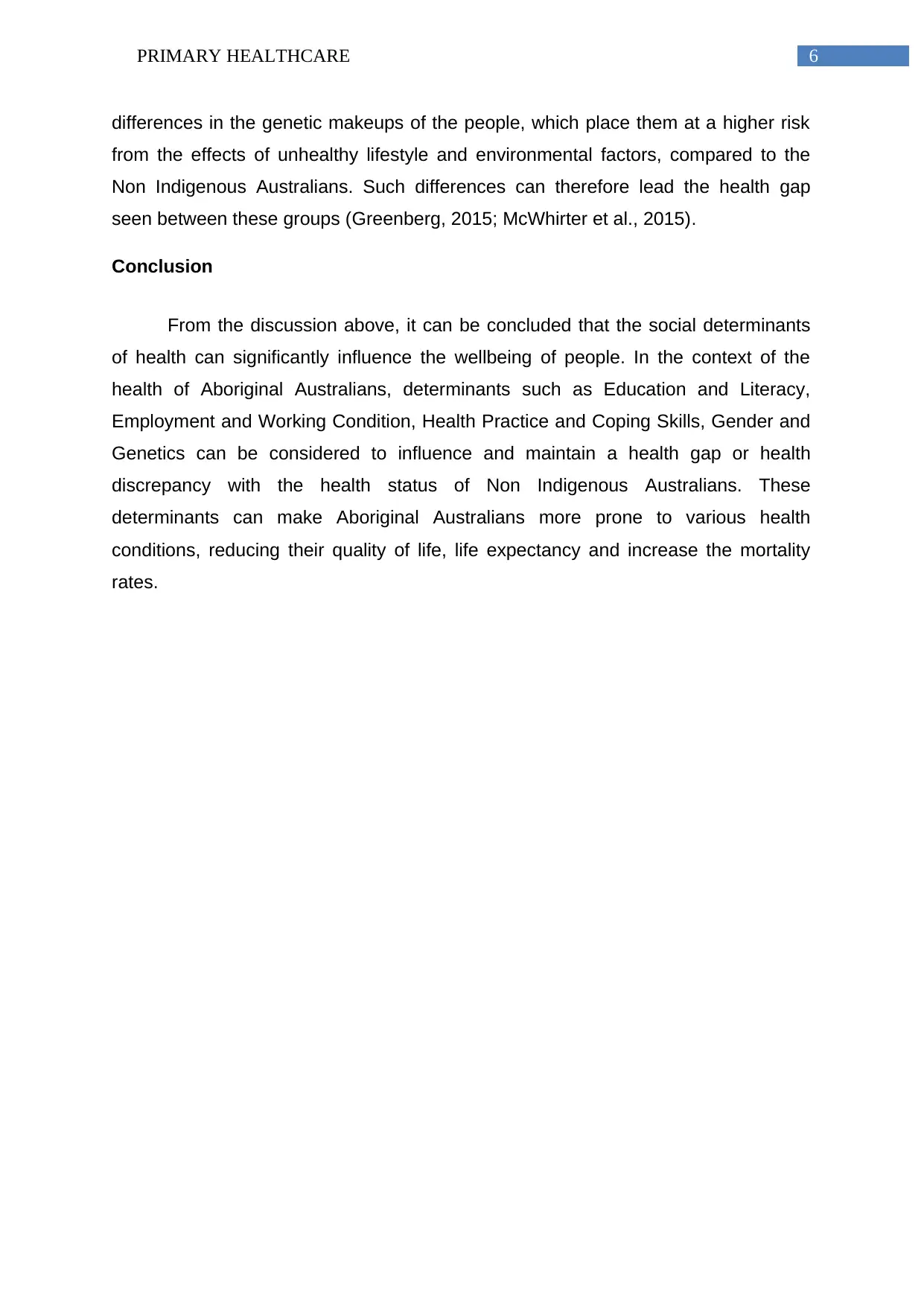
6PRIMARY HEALTHCARE
differences in the genetic makeups of the people, which place them at a higher risk
from the effects of unhealthy lifestyle and environmental factors, compared to the
Non Indigenous Australians. Such differences can therefore lead the health gap
seen between these groups (Greenberg, 2015; McWhirter et al., 2015).
Conclusion
From the discussion above, it can be concluded that the social determinants
of health can significantly influence the wellbeing of people. In the context of the
health of Aboriginal Australians, determinants such as Education and Literacy,
Employment and Working Condition, Health Practice and Coping Skills, Gender and
Genetics can be considered to influence and maintain a health gap or health
discrepancy with the health status of Non Indigenous Australians. These
determinants can make Aboriginal Australians more prone to various health
conditions, reducing their quality of life, life expectancy and increase the mortality
rates.
differences in the genetic makeups of the people, which place them at a higher risk
from the effects of unhealthy lifestyle and environmental factors, compared to the
Non Indigenous Australians. Such differences can therefore lead the health gap
seen between these groups (Greenberg, 2015; McWhirter et al., 2015).
Conclusion
From the discussion above, it can be concluded that the social determinants
of health can significantly influence the wellbeing of people. In the context of the
health of Aboriginal Australians, determinants such as Education and Literacy,
Employment and Working Condition, Health Practice and Coping Skills, Gender and
Genetics can be considered to influence and maintain a health gap or health
discrepancy with the health status of Non Indigenous Australians. These
determinants can make Aboriginal Australians more prone to various health
conditions, reducing their quality of life, life expectancy and increase the mortality
rates.
Paraphrase This Document
Need a fresh take? Get an instant paraphrase of this document with our AI Paraphraser
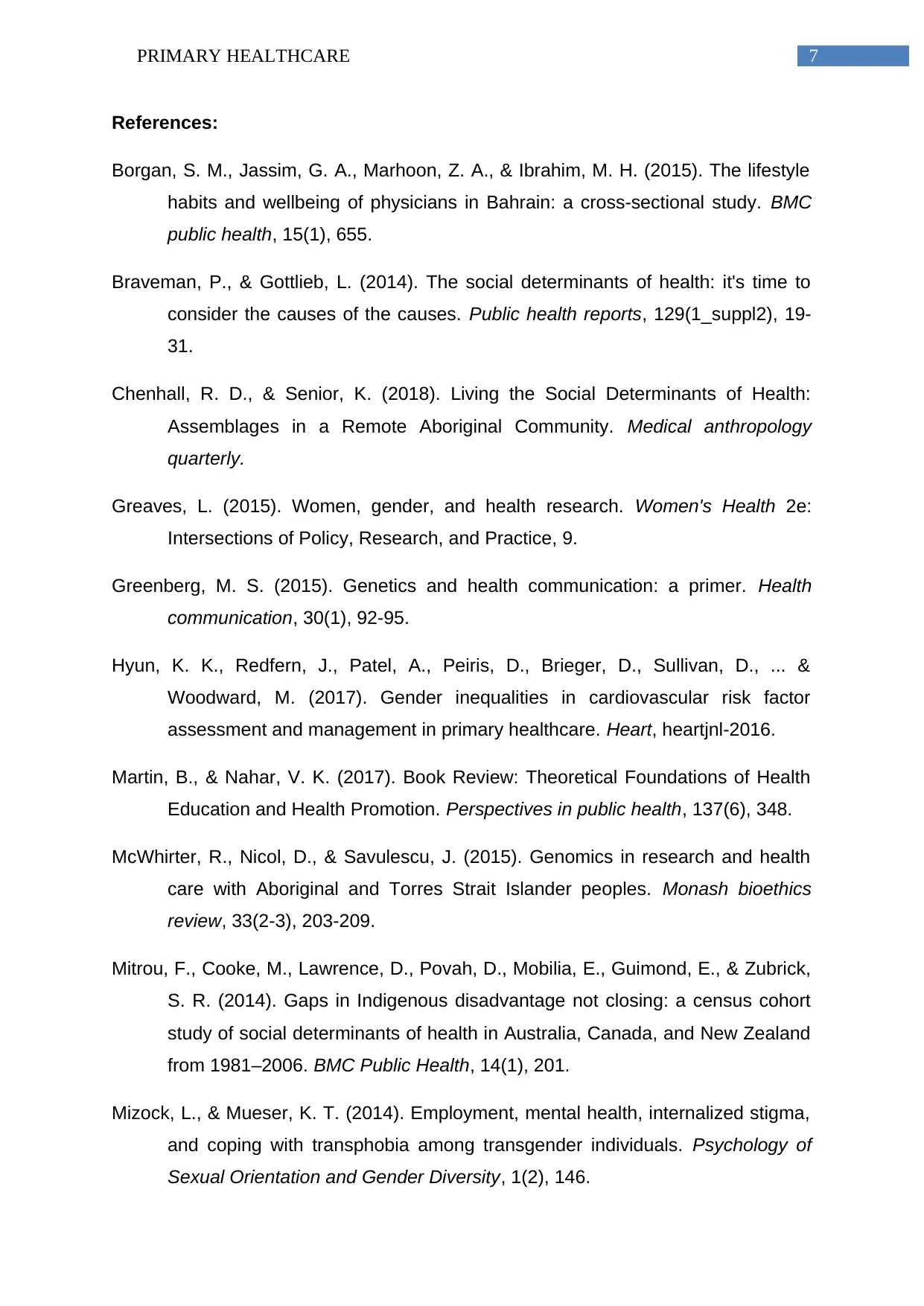
7PRIMARY HEALTHCARE
References:
Borgan, S. M., Jassim, G. A., Marhoon, Z. A., & Ibrahim, M. H. (2015). The lifestyle
habits and wellbeing of physicians in Bahrain: a cross-sectional study. BMC
public health, 15(1), 655.
Braveman, P., & Gottlieb, L. (2014). The social determinants of health: it's time to
consider the causes of the causes. Public health reports, 129(1_suppl2), 19-
31.
Chenhall, R. D., & Senior, K. (2018). Living the Social Determinants of Health:
Assemblages in a Remote Aboriginal Community. Medical anthropology
quarterly.
Greaves, L. (2015). Women, gender, and health research. Women's Health 2e:
Intersections of Policy, Research, and Practice, 9.
Greenberg, M. S. (2015). Genetics and health communication: a primer. Health
communication, 30(1), 92-95.
Hyun, K. K., Redfern, J., Patel, A., Peiris, D., Brieger, D., Sullivan, D., ... &
Woodward, M. (2017). Gender inequalities in cardiovascular risk factor
assessment and management in primary healthcare. Heart, heartjnl-2016.
Martin, B., & Nahar, V. K. (2017). Book Review: Theoretical Foundations of Health
Education and Health Promotion. Perspectives in public health, 137(6), 348.
McWhirter, R., Nicol, D., & Savulescu, J. (2015). Genomics in research and health
care with Aboriginal and Torres Strait Islander peoples. Monash bioethics
review, 33(2-3), 203-209.
Mitrou, F., Cooke, M., Lawrence, D., Povah, D., Mobilia, E., Guimond, E., & Zubrick,
S. R. (2014). Gaps in Indigenous disadvantage not closing: a census cohort
study of social determinants of health in Australia, Canada, and New Zealand
from 1981–2006. BMC Public Health, 14(1), 201.
Mizock, L., & Mueser, K. T. (2014). Employment, mental health, internalized stigma,
and coping with transphobia among transgender individuals. Psychology of
Sexual Orientation and Gender Diversity, 1(2), 146.
References:
Borgan, S. M., Jassim, G. A., Marhoon, Z. A., & Ibrahim, M. H. (2015). The lifestyle
habits and wellbeing of physicians in Bahrain: a cross-sectional study. BMC
public health, 15(1), 655.
Braveman, P., & Gottlieb, L. (2014). The social determinants of health: it's time to
consider the causes of the causes. Public health reports, 129(1_suppl2), 19-
31.
Chenhall, R. D., & Senior, K. (2018). Living the Social Determinants of Health:
Assemblages in a Remote Aboriginal Community. Medical anthropology
quarterly.
Greaves, L. (2015). Women, gender, and health research. Women's Health 2e:
Intersections of Policy, Research, and Practice, 9.
Greenberg, M. S. (2015). Genetics and health communication: a primer. Health
communication, 30(1), 92-95.
Hyun, K. K., Redfern, J., Patel, A., Peiris, D., Brieger, D., Sullivan, D., ... &
Woodward, M. (2017). Gender inequalities in cardiovascular risk factor
assessment and management in primary healthcare. Heart, heartjnl-2016.
Martin, B., & Nahar, V. K. (2017). Book Review: Theoretical Foundations of Health
Education and Health Promotion. Perspectives in public health, 137(6), 348.
McWhirter, R., Nicol, D., & Savulescu, J. (2015). Genomics in research and health
care with Aboriginal and Torres Strait Islander peoples. Monash bioethics
review, 33(2-3), 203-209.
Mitrou, F., Cooke, M., Lawrence, D., Povah, D., Mobilia, E., Guimond, E., & Zubrick,
S. R. (2014). Gaps in Indigenous disadvantage not closing: a census cohort
study of social determinants of health in Australia, Canada, and New Zealand
from 1981–2006. BMC Public Health, 14(1), 201.
Mizock, L., & Mueser, K. T. (2014). Employment, mental health, internalized stigma,
and coping with transphobia among transgender individuals. Psychology of
Sexual Orientation and Gender Diversity, 1(2), 146.

8PRIMARY HEALTHCARE
Pacquiao, D. F. (2016). Social Determinants of Health. Global Health Care: Issues
and Policies, 159.
Stevenson, F. (2018). Social Determinants of Health. Sociology as Applied to Health
and Medicine, 23.
Pacquiao, D. F. (2016). Social Determinants of Health. Global Health Care: Issues
and Policies, 159.
Stevenson, F. (2018). Social Determinants of Health. Sociology as Applied to Health
and Medicine, 23.
⊘ This is a preview!⊘
Do you want full access?
Subscribe today to unlock all pages.

Trusted by 1+ million students worldwide
1 out of 9
Related Documents
Your All-in-One AI-Powered Toolkit for Academic Success.
+13062052269
info@desklib.com
Available 24*7 on WhatsApp / Email
![[object Object]](/_next/static/media/star-bottom.7253800d.svg)
Unlock your academic potential
Copyright © 2020–2025 A2Z Services. All Rights Reserved. Developed and managed by ZUCOL.





